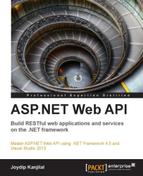ROA is primarily based on the concept of a resource. A resource is a distributable component that can be accessed through a standard, common interface. Each resource is associated to a unique identifier that comprises a URL.
The main concepts of ROA are centered on resources. Resources should have the following characteristics:
- A resource should be unique and maybe linked to other related resources.
- A resource should have a minimum of one representation.
- A resource should have attributes and schema, it should be accessible (through its address), and it should provide a context.
- A resource should have name; this is used to identify a resource uniquely. Resources are identified using URIs.
Although a resource link is used to represent another representation of the same resource or another resource, a resource interface is used to provide an interface to access a resource and manipulate its state information. A resource is represented using URIs. Note that data is a resource if it can be represented using a URI.
Examples of resources and URIs are as follows:
No two resources can be the same, but two or more resources can point to the same data. Here is an example:
http://www.packtpub.com/sales/2012/Q4http://www.packtpub.com/sales/2012/Q3
The following figure shows the relationship amongst a resource, its representation, and its URI:

Relation between Resource, Representation, and URI
The six basic properties that an ROA implementation should hold include the following:
- Addressability: This denotes the ability to share data and information via URIs.
- Statelessness: This implies that every request on a RESTful web service should be self-contained. In order to achieve this statelessness nature, all calls to a RESTful service should contain relevant bits of application state in each request.
- Connectedness: This implies that resources should contain links to related resources.
- Representation: A resource can have multiple representations. Each of these representations should have similar URIs. In essence, a URI should contain sufficient information needed by the server to produce the desired representation. A representation is actually the description of a resource. The representation of a resource distinctly describes its state information.
The four basic concepts that an ROA implementation should hold include:
- Addressability: Addressability of a resource is its ability to expose its data through well-formed URIs.
- Statelessness: This implies that every HTTP (moreover, because HTTP is a stateless protocol) request occurs in complete isolation.
- Connectedness: Connectedness is the ability of a resource to be connected with another resource. In essence, it is established using links to data of the same kind.
- A uniform interface: A RESTful service should have a uniform interface defined by HTTP's primary methods, that is, GET, PUT, POST, DELETE, and so on. Two or more representations of a particular resource are distinctly identified using URIs.
In this section, we will discuss the basics of HTTP protocol.
The following table shows the common HTTP methods and their purpose:
The following table shows the HTTP status codes and their purposes:
|
Status code |
Description |
|---|---|
|
100 |
Informational |
|
200 |
Successful |
|
201 |
Created |
|
202 |
Accepted |
|
300 |
Redirection |
|
304 |
Not modified |
|
400 |
Client error |
|
402 |
Payment required |
|
404 |
Not found |
|
405 |
Method not allowed |
|
500 |
Server error |
|
501 |
Not implemented |
The following table shows the HTTP redirection status codes:
|
Status Code |
Description |
|---|---|
|
300 |
Multiple choices |
|
301 |
Moved permanently |
|
302 |
Found (temporary redirection) |
The following table shows the HTTP error status codes:
|
Status code |
Description |
|---|---|
|
400 |
Bad request |
|
401 |
Unauthorized |
|
403 |
Forbidden |
|
404 |
Resource not found |
|
405 |
Method not allowed |
|
408 |
Request timeout |
|
409 |
Conflict |
|
413 |
Request entity too large |
|
415 |
Unsupported media type |
The following table shows the HTTP server error status codes:
|
Status Code |
Description |
|---|---|
|
500 |
Internal server error |
|
501 |
Not implemented |
|
503 |
Service unavailable |
|
505 |
HTTP version not supported |
The following table lists some resource methods and how they can be implemented using the HTTP protocol:
In the section that follows, we will explore ROA. We will discuss what a resource implies, the constraints, and so on.
